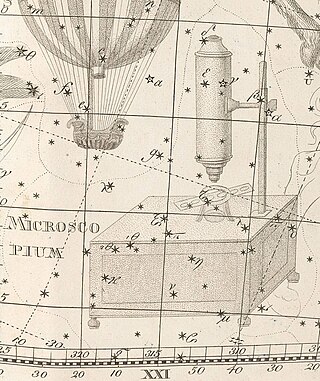라카유 8760
Lacaille 8760좌표:![]() 21h 17m 15.269s, −38° 52′ 02.51″
21h 17m 15.269s, −38° 52′ 02.51″
| 관측 데이터 에폭 J2000 이쿼녹스 J2000 | |
|---|---|
| 별자리 | 현미경 |
| 우측 상승 | 21h 17m 15.269s[3] |
| 탈위임 | −38° 52′ 02.51″[3] |
| 겉보기 크기 (V) | 6.67[4] |
| 특성. | |
| 스펙트럼형 | M0Ve[5][6] |
| U-B색지수 | +1.165[5] |
| B-V색지수 | +1.395[5] |
| 변수형 | 플레어 스타 |
| 아스트로메트리 | |
| 방사 속도 (Rv) | +20.7km[6]/s |
| 고유 운동 (μ) | RA: −3,258.553[3]mas/yr Dec.: -1,1996.396mas[3]/yr |
| 시차 (π) | 251.9124 ± 0.0352[7] 마스 |
| 거리 | 12.947 ± 0.002 ly (3.96 ± 0.0006 pc) |
| 절대치수 (MV) | 8.69[4] |
| 세부 사항 | |
| 미사 | 0.60[4] M☉ |
| 반지름 | 0.51[8] R☉ |
| 루미도(골수계) | 0.072[9] L☉ |
| 조명도(시각, LV) | 0.029 L☉ |
| 표면 중력 (log g) | 4.78[8] cgs |
| 온도 | 3,800K[10] |
| 금속성 [Fe/H] | −0.01±0.04[11] 덱스를 만들다 |
| 회전 | 40±12 d[12] |
| 회전 속도 (v sin i) | 3.3km[6]/s |
| 나이 | 4.8±2.9[13] Gyr |
| 기타 지정 | |
| 데이터베이스 참조 | |
| 심바드 | 자료 |
| Exoplanet 아카이브 | 자료 |
| 아리친스 | 자료 |
현미경자리 라카유 8760의 위치 | |
라카유 8760(AX 현미경자리)은 현미경자리에 있는 적색 왜성이다.망원경 없이는 일반적으로 볼 수 없을 정도로 희미하지만 약 12.9광년 거리에 있는 태양과 가장 가까운 별 중 하나이며, 지구 밤하늘에서 가장 밝은 M 왜성이다.외관상 크기 +6.7에서는 예외적으로 양호한 시야 조건과 어두운 하늘 아래 보조되지 않은 눈에만 볼 수 있다.
이 별은 원래 프랑스인 아베 니콜라스 루이 드 라카유에 의해 사후에 출판된 1763년 카탈로그에 수록되었다.그는 희망봉 전망대에서 일하면서 남쪽 하늘에서 그것을 관찰했다.[14]8760번은 1847년판 프란시스 베일에 의해 9766개의 별들로 구성된 라카유의 카탈로그에서 이 별에 배정되었다.[15]
과거 라카유 8760은 스펙트럼 등급 K7에서 M2까지 어느 곳에나 분류되어 왔다. 1979년 아일랜드의 천문학자 패트릭 번이 플레어 별이라는 것을 발견했고,[16] 그것은 변수 별 명칭인 AX 현미경자리(AX Miciciki)가 주어졌다.플레어 스타로서, 그것은 비교적 조용하며, 하루 평균 1회 이하로만 분출한다.
라카유 8760은 알려진 가장 크고 밝은 적색 왜성 중 하나로, 질량이 약 60%,[4] 태양의 반경이 51%[8]이다.약 50억년[13] 된 것으로 추정된 3.3km/s의 회전 속도로 회전하고 있어 [6]약 40일의 회전기간을 부여하고 있다.[12]이 별은 3,800K의 유효 온도에서 태양 광도의 7.[9]2%를 광구에서 방출하고 있다.[10]
천문학자들의 노력에도 불구하고, 2011년 현재 이 별 주위의 궤도에서 어떤 행성도 발견되지 않았다.[17]
라카유 8760번 궤도는 0.23의 타원성이 비교적 높은 은하계 주위를 돈다.[18]태양에 가장 가깝게 접근한 것은 약 2만년 전 12광년(3.7파섹) 내에 도달했을 때 일어났다.[19]질량이 낮기 때문에(태양의 60%) 태양보다 7배 [20]긴 약 750억년(7.5×1010)의 기대수명을 갖고 있다.
참조
- ^ e-rara.ch.요한 엘러트 보데우라노그래피아의 항성 지도책(1801), 타불라 16세
- ^ 요한 엘러트 보데알게마이네 베슈라이붕과 나흐베이성 데어 게스티르네(1801쪽), 67페이지
- ^ a b c Brown, A. G. A.; et al. (Gaia collaboration) (August 2018). "Gaia Data Release 2: Summary of the contents and survey properties". Astronomy & Astrophysics. 616. A1. arXiv:1804.09365. Bibcode:2018A&A...616A...1G. doi:10.1051/0004-6361/201833051.이 소스에 대한 가이아 DR2 기록 VizieR.
- ^ a b c d "The One Hundred Nearest Star Systems", RECONS, Georgia State University, retrieved 2015-06-25.
- ^ a b c d "V* AX Mic -- Flare Star", SIMBAD, Centre de Données astronomiques de Strasbourg, retrieved 2011-02-18.
- ^ a b c d Torres, C. A. O.; et al. (December 2006), "Search for associations containing young stars (SACY). I. Sample and searching method", Astronomy and Astrophysics, 460 (3): 695–708, arXiv:astro-ph/0609258, Bibcode:2006A&A...460..695T, doi:10.1051/0004-6361:20065602, S2CID 16080025. 온라인 데이터를 참조하십시오.
- ^ Brown, A. G. A.; et al. (Gaia collaboration) (2021). "Gaia Early Data Release 3: Summary of the contents and survey properties". Astronomy & Astrophysics. 649: A1. arXiv:2012.01533. Bibcode:2021A&A...649A...1G. doi:10.1051/0004-6361/202039657. S2CID 227254300. 이 소스에 대한 Gaia EDR3 레코드 VizieR.
- ^ a b c Takeda, Genya; et al. (February 2007), "Structure and Evolution of Nearby Stars with Planets. II. Physical Properties of ~1000 Cool Stars from the SPOCS Catalog", The Astrophysical Journal Supplement Series, 168 (2): 297–318, arXiv:astro-ph/0607235, Bibcode:2007ApJS..168..297T, doi:10.1086/509763, S2CID 18775378, retrieved 2011-08-26.
- ^ a b Moro-Martín, A.; et al. (March 2015). "Does the Presence of Planets Affect the Frequency and Properties of Extrasolar Kuiper Belts? Results from the Herschel Debris and Dunes Surveys". The Astrophysical Journal. 801 (2): 28. arXiv:1501.03813. Bibcode:2015ApJ...801..143M. doi:10.1088/0004-637X/801/2/143. S2CID 55170390.Vizier 카탈로그 항목
- ^ a b Gautier, Thomas N., III; et al. (September 2007), "Far-Infrared Properties of M Dwarfs", The Astrophysical Journal, 667 (1): 527–536, arXiv:0707.0464, Bibcode:2007ApJ...667..527G, doi:10.1086/520667, S2CID 15732144.
- ^ Lindgren, Sara; Heiter, Ulrike (2017). "Metallicity determination of M dwarfs. Expanded parameter range in metallicity and effective temperature". Astronomy and Astrophysics. 604: A97. arXiv:1705.08785. Bibcode:2017A&A...604A..97L. doi:10.1051/0004-6361/201730715. S2CID 119216828.
- ^ a b Byrne, P. B.; Doyle, J. G. (January 1989), "Activity in late-type dwarfs. III - Chromospheric and transition region line fluxes for two dM stars", Astronomy and Astrophysics, 208 (1–2): 159–165, Bibcode:1989A&A...208..159B.
- ^ a b Boehle, A.; et al. (October 2019), "Combining high-contrast imaging and radial velocities to constrain the planetary architectures of nearby stars", Astronomy & Astrophysics, 630: 17, arXiv:1907.04334, Bibcode:2019A&A...630A..50B, doi:10.1051/0004-6361/201935733, A50.
- ^ Croswell, Ken (July 2003), "The Brightest Red Dwarf", Sky & Telescope: 32, retrieved 2011-02-18.
- ^ 프랜시스 베일리9766개의 별 목록(1847), 219페이지
- ^ a b Byrne, P. B. (April 1981), "Gliese 825 - A new flare star", Monthly Notices of the Royal Astronomical Society, 195 (2): 143–147, Bibcode:1981MNRAS.195..143B, doi:10.1093/mnras/195.2.143.
- ^ Carson, J. C.; et al. (December 2011), "Low-mass evolution - Zero-age main sequence to asymptotic giant branch", The Astrophysical Journal, 743 (2): 141, arXiv:1110.2191, Bibcode:2011ApJ...743..141C, doi:10.1088/0004-637X/743/2/141, S2CID 119270911.
- ^ Allen, C.; Herrera, M. A. (April 1998), "The Galactic Orbits of Nearby UV Ceti Stars", Revista Mexicana de Astronomía y Astrofísica, 34: 37–46, Bibcode:1998RMxAA..34...37A.
- ^ García-Sánchez, J.; et al. (2001), "Stellar encounters with the solar system" (PDF), Astronomy and Astrophysics, 379 (2): 634–659, Bibcode:2001A&A...379..634G, doi:10.1051/0004-6361:20011330.
- ^ Despain, K. H. (December 1981), "Low-mass evolution - Zero-age main sequence to asymptotic giant branch", Astrophysical Journal, Part 1, 251: 639–653, Bibcode:1981ApJ...251..639D, doi:10.1086/159510.





